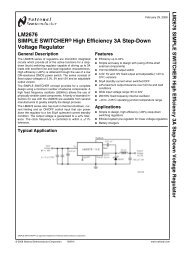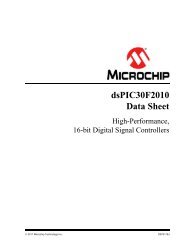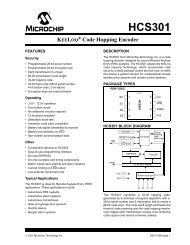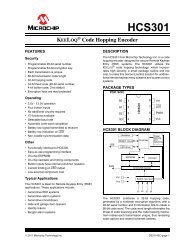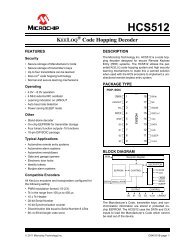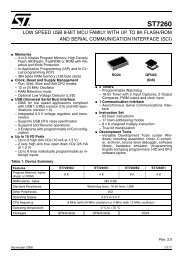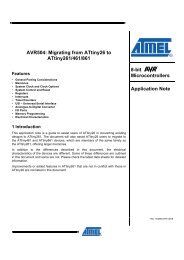You also want an ePaper? Increase the reach of your titles
YUMPU automatically turns print PDFs into web optimized ePapers that Google loves.
General-purpose timers<br />
<strong>STM32W108C8</strong><br />
Figure 25.<br />
TI2 external clock connection example<br />
Note:<br />
For example, to configure the up-counter to count in response to a rising edge on the TI2<br />
input, use the following procedure:<br />
1. Configure channel 2 to detect rising edges on the TI2 input by writing TIM_CC2S = 01<br />
in the TIMx_CCMR1 register.<br />
2. Configure the input filter duration by writing the TIM_IC2F bits in the TIMx_CCMR1<br />
register (if no filter is needed, keep TIM_IC2F = 0000).<br />
The capture prescaler is not used for triggering, so it does not need to be configured.<br />
3. Select rising edge polarity by writing TIM_CC2P = 0 in the TIMx_CCER register.<br />
4. Configure the timer in external clock mode 1 by writing TIM_SMS = 111 in the<br />
TIMx_SMCR register.<br />
5. Select TI2 as the input source by writing TIM_TS = 110 in the TIMx_SMCR register.<br />
6. Enable the counter by writing TIM_CEN = 1 in the TIMx_CR1 register.<br />
When a rising edge occurs on TI2, the counter counts once and the INT_TIMTIF flag is set.<br />
The delay between the rising edge on TI2 and the actual clock of the counter is due to the<br />
resynchronization circuit on the TI2 input.<br />
Figure 26. Control circuit in External Clock mode 1<br />
119/215 Doc ID 018587 Rev 2





